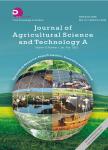Relationships between Agronomic Practices, Soil Chemical Characteristics and Striga Reproduction in Dryland Areas of Tanzania
Relationships between Agronomic Practices, Soil Chemical Characteristics and Striga Reproduction in Dryland Areas of Tanzania作者机构:Department of Land Resource Management and Agricultural Technology University of Nairobi Nairobi Kenya Department of Crop Science and Production Sokoine University of Agriculture Morogoro Tanzania Department of Plant Science and Crop Protection University of Nairobi Nairobi Kenya
出 版 物:《Journal of Agricultural Science and Technology(A)》 (农业科学与技术(A))
年 卷 期:2012年第2卷第10期
页 面:1134-1141页
主 题:Parasitic weed Striga reproduction dryland agronomic practices soil P and K.
摘 要:The parasitic weed Striga poses a serious threat to cereal production in sub-Saharan Africa. For many years, technological packages for the control of this weed were proposed and implemented on farmers' fields. A survey was carried out in farmers' fields in 2010/201l cropping season in selected dryland areas of Tanzania to: (a) determine the Striga plant counts, number of capsules/Striga plant and agronomic practices used by farmers to control Striga; and (b) evaluate the relationship between Striga reproduction, soil chemical characteristics and agronomic practices. Soil samples at 0-20 cm depth were collected from 20 different farmers' fields. The soil samples were analyzed for pH, organic carbon, N, P and K. Results showed that there was low adoption of recommended Striga control methods. Regression analysis of agronomic practices and soil chemical characteristics revealed a positive improvement of soil N and organic carbon and reduction of soil P and K content as one shifted from sole planting to intercropping. The results showed that potassium was highly positively related to number of capsules/Striga plant. There was a reduction in the number of capsules/plant as one moved from sole planting to intercropping. Based on these findings, K in the Striga infested in soils positively influenced Striga reproduction and seed bank replenishment, hence high soil K levels may lead to high Striga incidence.



